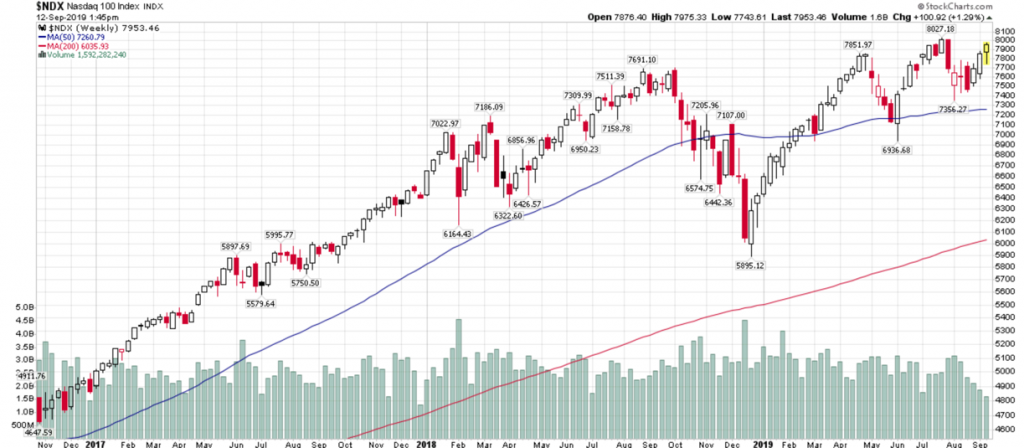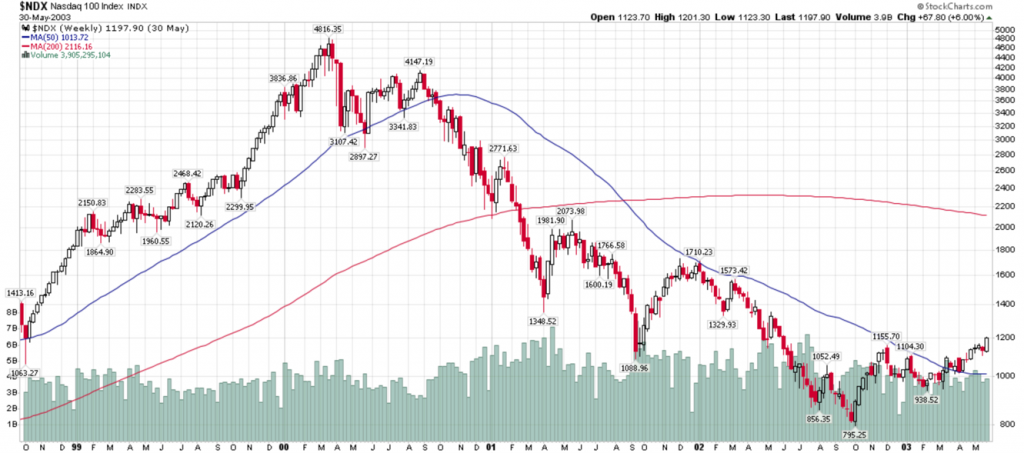by Patrick Hill, The Progressive Ensign
Since November of 2016, the NDX has soared by 72% and is poised to break the recent all-time high of 8027. Today, it seems that sentiment is shifting back to selling bonds and buying riskier equities with hyped estimates. FAANG stocks have fueled an ongoing rally, via stock buybacks, non – GAAP financial gimmicky, and promises of eventual profitability for many unicorn startups.

Source: Stockcharts.com – 9/12/19
Sentiment has moved prices up as the market has suspended its disbelief of key fundamentals like future earnings, declining sales, job layoffs, contracting world trade, and negative cash flow.
First, let’s look at downward revised earnings forecasts for the rest of the year indicating a decline almost to a contraction level in the U.S.:

Sources: Bloomberg, IIF – 9/10/19
Analysts expect lower earnings and profitability due to declining sales. The pivotal function of any business is sales. The inventory to sales ratio is now at 2008 levels indicating that sales are declining while production is continuing, which is typical of the later stages in the business cycle:

Sources: The Wall Street Journal, The Daily Shot – 9/12/19
Continuing present production levels with flat to declining sales is unsustainable. Executives are faced with declining sales overseas in part due to tariffs. As such, the number of production shifts must be reduced, as the highest cost for most businesses is payroll. A key indicator of executives beginning to reduce staff is indicated by an increase in jobless claims in five key manufacturing states starting about when tariffs were first enacted in November of 2018:

Sources: B of A Merrill, Haver, The Wall Street Journal, The Daily Shot – 8/30/19
Markets are underestimating the devasting impact that broad tariffs are having on U.S. corporate sales. S & P 100 corporations generally recognize from 50 – 60 % of total sales from overseas, and profits of 15 – 25 % or more from emerging markets like China and India. When tariffs hit U.S. products, there is a cascading effect on small businesses, and throughout the worldwide supply chain. Even if a product is produced domestically, many of the sourced parts come from several emerging markets which now face tariffs. China’s tariffs on U.S. farm products like soybeans have reduced sales by 90 %. Soybean farmers are looking for new markets, but are having a difficult time replacing the massive purchases that China makes each year. Tariffs are culminating sales headwinds and investment uncertainty at the fastest rate since 2008.

Sources: CPB World Monitor, The Wall Street Journal, The Daily Shot – 9/11/19
In the midst of all these economic and business headwinds, executives should be running tight finances, right? Well, not exactly. Due to a surge in debt issuance, corporations now have the highest debt to GDP ratio in history. However, they may not have learned about how to keep out of financial trouble. S & P 500 corporations are paying out more cash than they are taking in, creating a cash flow crunch at a – 15 % rate (that’s right they are burning cash) to maintain stock buyback and dividend levels:

Sources: Compustat, Factset, Goldman Sachs – 7/25/19

Source: RIA PRO (www.riapro.net) Chart of the Day -9/10/2019
Unicorn IPO valuations are off the chart, many with unproven business models and large losses. 2019 has seen the highest value of IPOs since 2000, an indicator of high interest in risky investments and soaring investor sentiment. Not surprising, 2019 has the highest number of negative earnings per share IPO companies since 2000 as well.

Sources: Dealogic, The Wall Street Journal, The Daily Shot – 6/18/19

Sources: Jay Ritter, University of Florida, The Wall Street Journal – 3/16/18
The lack of profitability and the number of IPOs ‘to cash out before it’s too late’ evokes memories of the 2000 Dotcom Crash. Then, investors were looking for ‘high tech growth’ stocks, and as it was assumed that companies would figure out their business model later.
When? As an example, Uber just recorded a $5.24 billion loss for the 2nd quarter of 2019. Lyft lost $644 million in the same quarter. Despite the popularity of their services, the business models for both ride-sharing companies has yet to be proven. Making profitability even harder for these companies, the State of California legislature just passed a bill recognizing ride-sharing drivers as employees and not contractors. Gov. Gavin Newsom is expected to sign the legislation. If Uber and Lyft have to pay salaries, benefits and other costs for full-time employees they will incur staggering costs, and may likely never be profitable. Uber says it is building a ‘transportation platform’ where drivers are delivering food and packages not transporting passengers so they can avoid being labeled a passenger transportation company. Both firms are planning to put an initiative on the ballot to declare their drivers as contractors to save their business models. It is still unclear, even with drivers being recognized as contractors, that they have viable business models. Yet investors just didn’t care at IPO time, though both stocks have since dropped in price dramatically since their IPO dates. Ride sharing is just one small industry and one example. There are many other unicorns with questionable businesses that are flourishing in the markets.
The suspended disbelief we see today is similar to the sentiment that sent the NDX up nearly 400% just before the Y2K crash. We can learn from what happened beginning 20 months before the Y2K crash. The NDX started in October of 1998 at 1063 and peaked at 4816 in May of 2000:

That astounding move up was followed by a roller coaster ride down to 2897 for a 38 % decline by May of 2000, followed further by a two year decline to 795, or 84 % decline from the 2000 peak. The NDX would not reach the 4816 level again for another 16 years! Investors had to wait a long time just to break even.
One similarity to the Y2K related drop in sales we see today is from tariffs. Companies have pulled purchases forward to avoid tariffs. Similar activity occurred in 1999 as IT departments bought new software and hardware to solve a possible year 2000 (Y2K) software bug. Software and hardware purchases were pulled forward into 1999, then as one IT manufacturer CEO put it ‘the lights went out on sales.’ The hard dates for tariff increases a year ago forced corporations to pull up purchases that would otherwise be made later in the year, resulting in an unnatural boost followed by a contraction of business activity.
Consumer products will be hit with 15 % tariffs in October and 25 % in December, so consumer, like businesses, are likely moving up their purchases. We expect consumer spending to show increases in August, and September, and decline after that. A contraction in consumer business operations is likely to follow pulled up consumer purchases.
Plus, investors need to be cognizant of the huge transformation of the world trade infrastructure into two competing trade blocks triggered by the trade war by the U.S. and China as discussed in my post: Navigating A Two Block Trading World. The forming of two trade blocks will change the character of world trade, and therefore create uncertainty in international sales for all businesses dependent on overseas customers to maintain growth and profitability.
Today, sentiment is set in suspended disbelief that ‘the Fed will cut rates’ and make the economy grow. Corporations are swimming in low-cost debt, with negative cash flows and flat to falling sales. If the Fed governors pick up an attaché case with a sales pitch and get sales going again then the Fed might have an impact on corporate profitability. Yes, cheap money may help stave off layoffs or cost reductions, but in the end businesses will have to cut costs to match new lower sales levels.
The market ‘hopes’ that a trade deal will revive the economy as well. An ‘interim’ trade deal where China gives up very little except a commitment to purchase agriculture and livestock products in return for a suspension of increased tariffs won’t change the broad-based tariff damage to the economy. Unless broad-based tariffs are ended, as 1,100 economists recommended in a letter to the Trump administration 18 months ago, the hemorrhaging of sales will continue.
So what can we learn from today’s investor sentiment compared to sentiment observed during the Dotcom crash? When the market finally ends its disbelief and is hit with the reality of business fundamentals, the decline will be fast and deep. The melt up, or whatever is left of it, will trigger a melt down. The 4:1 return difference in the 2000 melt up versus today’s melt up today is likely due to the 4.7 % GDP rate in 1999 versus the forecasted 1.7 % GDP forecasted for 2nd quarter this year. In 2000, the economy was simply growing a lot faster than today, and productivity was rapidly growly. This helped sentiment and provided some basis for the melt up. Further the melt up in 1999 was fueled by the Fed providing excessive liquidity to help ensure that Y2K did not shut down the economy.
The current melt up is occurring at a much lower level of economic activity. Yet, both instances are based on a disconnect between what is happening in the economy and the valuations of stocks. The longer the disconnect with fundamentals, the longer it will take for the reversion to the mean to rebalance the economy. Plus, the further the disconnect the larger reversion to the mean or even an overshoot and it will take longer to get back to ‘even’ – maybe 16 years from the peak as we saw in Dotcom Crash in 2000.
Patrick Hill is the Editor of The Progressive Ensign, https://theprogressiveensign.com/ writes from the heart of Silicon Valley, leveraging 20 years of experience as an executive at firms like HP, Genentech, Verigy, Informatica and Okta to provide investment and economic insights. Twitter: @PatrickHill1677.














